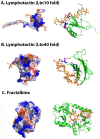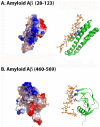The "CPC clip motif": a conserved structural signature for heparin-binding proteins
- PMID: 22880084
- PMCID: PMC3412806
- DOI: 10.1371/journal.pone.0042692
The "CPC clip motif": a conserved structural signature for heparin-binding proteins
Abstract
Glycosaminoglycans (GAGs) are essential molecules that regulate diverse biological processes including cell adhesion, differentiation, signaling and growth, by interaction with a wide variety of proteins. However, despite the efforts committed to understand the molecular nature of the interactions in protein-GAG complexes, the answer to this question remains elusive.In the present study the interphases of 20 heparin-binding proteins have been analyzed searching for a conserved structural pattern. We have found that a structural motif encompassing one polar and two cationic residues (which has been named the CPC clip motif) is conserved among all the proteins deposited in the PDB. The distances between the α carbons and the side chain center of gravity of the residues composing this motif are also conserved. Furthermore, this pattern can be found in other proteins suggested to bind heparin for which no structural information is available. Hence we propose that the CPC clip motif, working like a staple, is a primary contributor to the attachment of heparin and other sulfated GAGs to heparin-binding proteins.
Conflict of interest statement
Figures





References
-
- Gandhi NS, Mancera RL (2008) The structure of glycosaminoglycans and their interactions with proteins. Chem Biol Drug Des 72: 455–482. - PubMed
-
- Peplow PV (2005) Glycosaminoglycan: a candidate to stimulate the repair of chronic wounds. Thromb Haemost 94: 4–16. - PubMed
-
- Casu B, Guerrini M, Torri G (2004) Structural and conformational aspects of the anticoagulant and anti-thrombotic activity of heparin and dermatan sulfate. Curr Pharm Des 10: 939–949. - PubMed
-
- Kovensky J (2009) Sulfated oligosaccharides: new targets for drug development? Curr Med Chem 16: 2338–2344. - PubMed
-
- Liu D, Shriver Z, Qi Y, Venkataraman G, Sasisekharan R (2002) Dynamic regulation of tumor growth and metastasis by heparan sulfate glycosaminoglycans. Semin Thromb Hemost 28: 67–78. - PubMed
Publication types
MeSH terms
Substances
Associated data
- Actions
LinkOut - more resources
Full Text Sources
Other Literature Sources
Medical

